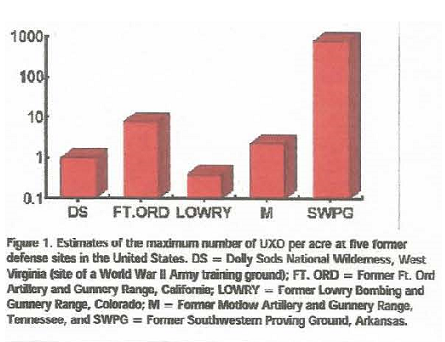UXO Problems at the US Army's Former Southwestern Proving Ground
Have you ever heard of a town called Hope, Arkansas? It should ring a bell. It's the boyhood home of Bill Clinton the forty-second President of the United States. But Hope was the home of the Southwestern Proving Ground (SWPG) during World War II. Built at a cost of $1,300,000, it also had the largest airfield in the state. At one time, SWPG had the reputation of having the highest concentration of UXO's per acre.
The SWPG was a 50,000 acre joint Army and Army Air Corps facility established in 1942 and closed in September 1945. SWPG's primary mission was to determine by actual firing tests of samples that all of the ammunition issued to the Army by the Ordnance Department was safe to handle and store as well as function properly when used in service by the troops. The explosives included small arms ammunition, artillery rounds, mortars, rockets, grenades, 500-pound bombs and 20-mm, 37-mm, 40-mm, 57-mm, 75-mm, 76-mm, 81-mm, 90-mm, 105-mm, 120-mm, and 155-mm projectiles.
The proving ground was closed shortly after World War II and ordnance was cleared from the surface of the base. The land was then conveyed to state, municipal and private owners. Since the clearance after World War II, munitions and explosives of concern have worked their way to the surface. The ordnance could be explosive and dangerous despite being more than 70 years old. Two young boys died in April 1944 from playing "bomber" with a 37mm round that detonated. Also, seven civilian deaths occurred in January 1949 near the former SWPG. It involved a 75mm shell taken from SWPG that exploded as it was being dismantled for sale as scrap leaving five persons dead. At one point, the Army actually condemned the area as being uninhabitable and unfit for any use because of the danger of unexploded bombs and shells. The U.S. Army Corps of Engineers, under its Formerly Used Defense Sites (FUDS) program, began cleanup of the SWPG in 1993. Over 8,000 ordnance items were removed from the site by 2003. The SWPG had one of the highest UXO per acre percentage levels at 800 UXO's per acre at the SWPG. See Figure 1.
Educational displays and programs were established at the former SWPG to inform the public of the risk and to inspire appropriate behavior to minimize risk. Because of the proving ground's large area and the widespread incidence of ordnance, the risk cannot be completely eliminated. Additional munitions and explosives of worry could be found in the future.










